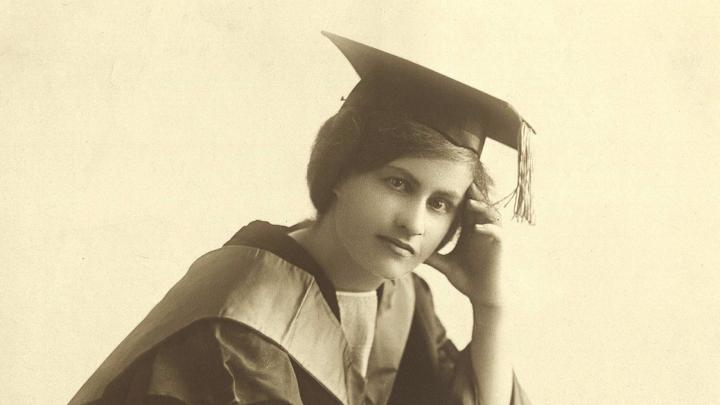Lorna Myrtle Hodgkinson, Ed.D. ’22, of Australia was the first woman to obtain a doctorate from Harvard University. In a long letter to Dean Henry Wyman Holmes of the Graduate School of Education, she cast herself in the role of a fairytale heroine:
I reached New York City in June 1920 prior to going to Harvard. Here, for the first time I met Miss Buckler and Miss Pfitzner who had heard of my arrival…that I was there at government expense appalled them and they took no pains to hide their feelings. Indeed they made me think of Cinderella’s step-sisters. They predicted that at Harvard I would not be able to compete with the better students and that my failure to succeed was a sure thing.…But I went to Harvard and I succeeded in spite of Miss Buckler’s prediction. In June 1921 when I took my Masters Degree I felt so “cocky” that I decided to let Miss Buckler know.…I wrote to her and sent her a knot of Crimson and white ribbon and asked her to wear it for Harvard on Commencement day…from that knot of crimson and white sprang the roots of the present vendetta which has brought about such lasting and immoveable calamity.
Buckler and Pfitzner had come to America in 1919 at their own expense to study the education of the “feeble-minded” and were enrolled as undergraduates at Columbia University. Lorna Hodgkinson had trained in Western Australia but had transferred to New South Wales.
Hodgkinson initially worked with Professor Walter Fenno Dearborn at Harvard Summer School but stayed on with the hope of enrolling in the new Graduate School of Education, which requested more evidence of her qualifications before admitting her. She wrote to Dean Holmes that she was sending certified letters via the Niagara to obtain the needed certification. The Niagara docked in Sydney late on Sunday, December 12, 1920. Alfred William Green, president of the State Children’s Relief Department, signed three documents that Wednesday. Among other inaccuracies, he described Hodgkinson as attending the Training College in Perth instead of the Normal School, although Hodgkinson correctly named the Normal School on her application for admission.
The GSE Administrative Board voted to admit Hodgkinson on February 18, 1921: “The Board reached this decision in view of the somewhat unusual character of your normal-school training and the extent and character of your subsequent work in research.” Hodgkinson received the M.Ed., was one of the class marshals at Commencement, and was granted a faculty scholarship to stay for an extra year. Sometime that year, Buckler sent the first of a series of letters to Harvard claiming that Hodgkinson should not have been admitted. In a fateful letter, Holmes responded to Buckler with excerpts from A.W. Green’s letters to justify Harvard’s decision.
For her thesis, Hodgkinson studied the records of more than 1,000 Massachusetts students who had been held back a grade. She found these to be heterogeneous. Some were of high intelligence who had specific learning disabilities or who had missed school because of physical illness or for whom English was a second language. A few were disciplinary cases or suffered from psychopathology. Most with below-average intelligence had the potential to be economically independent. Only a small proportion were “feeble-minded.” Hodgkinson believed that making students repeat a grade benefited none. The students of below-average intelligence would be best served by instruction in practical subjects. She favored segregation of the “feeble-minded” students in independent institutions.
Hodgkinson was appointed Superintendent of Education for mental defectives on her return to Sydney. Green had retired during her absence and Stanley Henry Smith had become Director of Education. Hodgkinson’s relationship with Smith rapidly soured, in part because she publicly advocated for changes in the education of the “feeble-minded.” At some time, Smith came into possession of a copy of Holmes’s letter to Buckler. Smith instituted inquiries that led to Hodgkinson’s dismissal in April 1924, in part because she had obtained her Harvard degrees under false pretenses.
Despite this public humiliation, Hodgkinson began recruiting families for a private institution. On Christmas night 1924, Hodgkinson wrote to Holmes describing how she had picked herself out of the ashes:
One day as I walked along the banks of the beautiful Lane Cove River, I made a wonderful find for standing in 15 acres of gorgeous garden land I discovered a beautiful old mansion….The lovely garden was overgrown with neglected shrubbery and the windows were broken.…I crawled into the garden thro a broken fence…the place had been a well equipped school long since deserted, and left to go to ruin. It was the place of my dreams.
The Sunshine Training Institute opened in September 1924. Hodgkinson administered the institute capably until her death in 1951, at which time she left the bulk of her £55,811 estate to a trust to continue its work; now known as Unisson Disability, it operates to this day.







